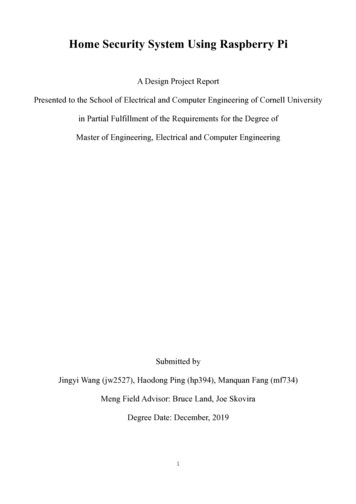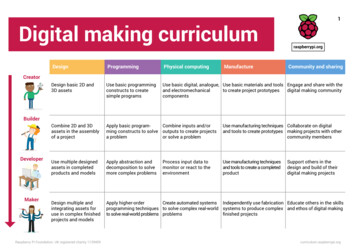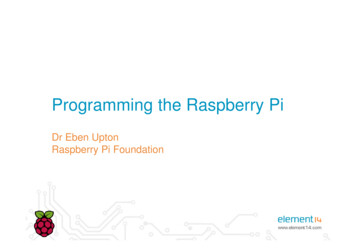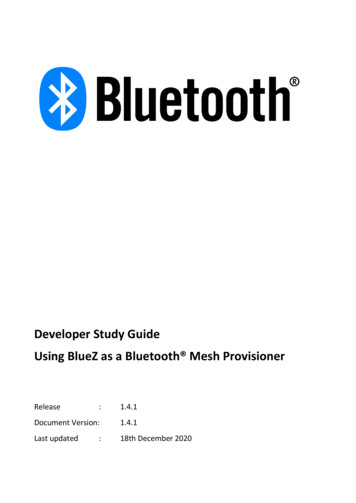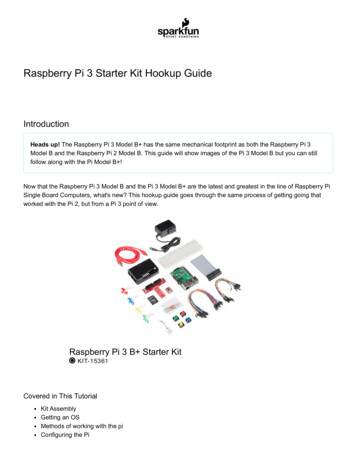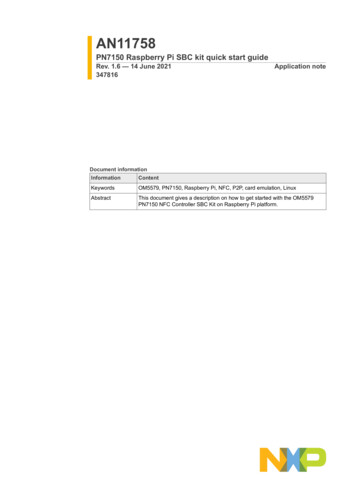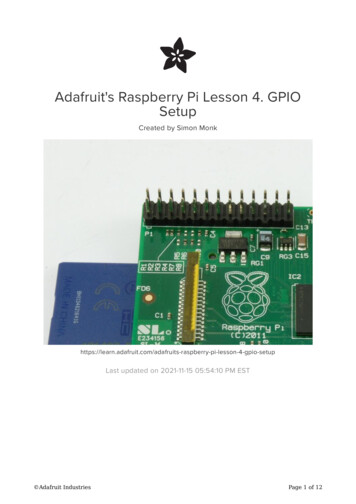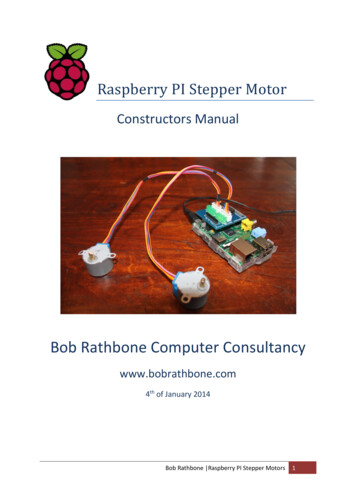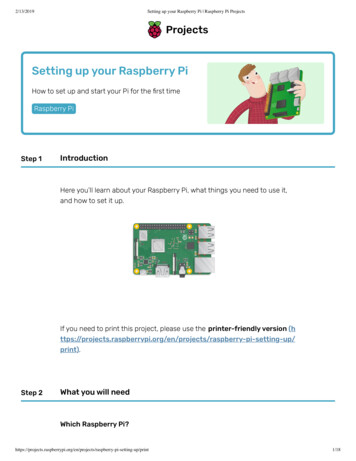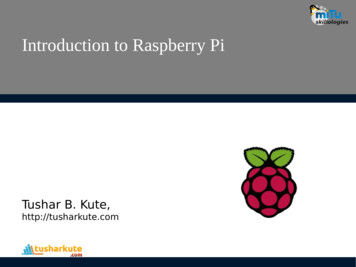
Transcription
Introduction to Raspberry PiTushar B. Kute,http://tusharkute.com
What is Raspberry Pi? The Raspberry Pi is a series of small single-boardcomputers developed in the United Kingdom by theRaspberry Pi Foundation to promote the teaching ofbasic computer science in schools and in developingcountries. The original model became far more popular thananticipated, selling outside of its target market for usessuch as robotics. Over 5 million Raspberry Pis have been sold beforeFebruary 2015, making it the best-selling Britishcomputer. By November 2016 they had sold 11 millionunits.
Raspberry Pi Sale
Raspberry Pi 3 Model B
The Timeline The first generation (Raspberry Pi 1 Model B) was released inFebruary 2012. It was followed by a simpler and inexpensivemodel Model A. In 2014, the foundation released a board with an improveddesign in Raspberry Pi 1 Model B . These boards areapproximately credit-card sized and represent the standardmainline form-factor. Improved A and B models were released a year later. A"compute module" was released in April 2014 for embeddedapplications, and a Raspberry Pi Zero with smaller size andreduced input/output (I/O) and general-purpose input/output(GPIO) capabilities was released in November 2015 for US 5.
The Timeline The Raspberry Pi 2 which added more RAM was released inFebruary 2015. Raspberry Pi 3 Model B released in February 2016, isbundled with on-board WiFi, Bluetooth and USB bootcapabilities. As of January 2017, Raspberry Pi 3 Model B is the newestmainline Raspberry Pi. Raspberry Pi boards are priced between US 5–35. As of 28 February 2017, the Raspberry Pi Zero W waslaunched, which is identical to the Raspberry Pi Zero, buthas the Wi-Fi and Bluetooth functionality of the RaspberryPi 3 for US 10.
Features All models feature a Broadcom system on a chip(SoC), which includes an ARM compatible centralprocessing unit (CPU) and an on-chip graphicsprocessing unit (GPU, a VideoCore IV). CPU speed ranges from 700 MHz to 1.2 GHz forthe Pi 3 and on board memory range from 256MB to 1 GB RAM. Secure Digital (SD) cards are used to store theoperating system and program memory in eitherthe SDHC or MicroSDHC sizes.
Features Most boards have between one and fourUSB slots, HDMI and composite videooutput, and a 3.5 mm phono jack for audio. Lower level output is provided by a numberof GPIO pins which support commonprotocols like I²C. The B-models have an 8P8C Ethernet portand the Pi 3 and Pi Zero W have on boardWi-Fi 802.11n and Bluetooth.
Operating System The Foundation provides Raspbian, a Debianbased Linux distribution for download, as wellas third party Ubuntu, Windows 10 IOT Core,RISC OS, and specialised media centerdistributions. It promotes Python and Scratch as the mainprogramming language, with support for manyother languages. The default firmware is closed source, while anunofficial open source is available.
Hardware
Hardware This block diagram depicts Models A, B, A , and B . ModelA, A , and the Pi Zero lack the Ethernet and USB hubcomponents. The Ethernet adapter is internally connected to anadditional USB port. In Model A, A , and the Pi Zero, the USB port is connecteddirectly to the system on a chip (SoC). On the Pi 1 ModelB and later models the USB/Ethernet chip contains a fivepoint USB hub, of which four ports are available, while thePi 1 Model B only provides two. On the Pi Zero, the USB port is also connected directly tothe SoC, but it uses a micro USB (OTG) port.
Processor The Broadcom BCM2835 SoC used in the first generation RaspberryPi is somewhat equivalent to the chip used in first moderngeneration smartphones (its CPU is an older ARMv6 architecture),which includes a 700 MHz ARM1176JZF-S processor, VideoCore IVgraphics processing unit (GPU), and RAM. It has a level 1 (L1) cache of 16 KB and a level 2 (L2) cache of 128 KB.The level 2 cache is used primarily by the GPU. The SoC is stackedunderneath the RAM chip, so only its edge is visible. The Raspberry Pi 2 uses a Broadcom BCM2836 SoC with a 900 MHz32-bit quad-core ARM Cortex-A7 processor, with 256 KB shared L2cache. The Raspberry Pi 3 uses a Broadcom BCM2837 SoC with a 1.2 GHz64-bit quad-core ARM Cortex-A53 processor, with 512 KB shared L2cache
Performance The Raspberry Pi 3, with a quad-core Cortex-A53 processor,is described as 10 times the performance of a Raspberry Pi1. This was suggested to be highly dependent upon taskthreading and instruction set use. Benchmarks showed theRaspberry Pi 3 to be approximately 80% faster than theRaspberry Pi 2 in parallelized tasks. Raspberry Pi 2 includes a quad-core Cortex-A7 CPU runningat 900 MHz and 1 GB RAM. It is described as 4–6 times morepowerful than its predecessor. The GPU is identical to theoriginal. In parallelized benchmarks, the Raspberry Pi 2could be up to 14 times faster than a Raspberry Pi 1 ModelB .
RAM The Raspberry Pi 2 and the Raspberry Pi 3have 1 GB of RAM. The Raspberry Pi Zero and Zero W have512 MB of RAM.
Networking The Model A, A and Pi Zero have no Ethernet circuitryand are commonly connected to a network using anexternal user-supplied USB Ethernet or Wi-Fi adapter. On the Model B and B the Ethernet port is provided by abuilt-in USB Ethernet adapter using the SMSC LAN9514chip. The Raspberry Pi 3 and Pi Zero W (wireless) are equippedwith 2.4 GHz WiFi 802.11n (150 Mbit/s) and Bluetooth 4.1(24 Mbit/s) based on Broadcom BCM43438 FullMAC chipwith no official support for Monitor mode butimplemented through unofficial firmware patching andthe Pi 3 also has a 10/100 Ethernet port.
Peripherals The Raspberry Pi may be operated withany generic USB computer keyboard andmouse. It may also be used with USB storage, USBto MIDI converters, and virtually any otherdevice/component with USB capabilities. Other peripherals can be attached throughthe various pins and connectors on thesurface of the Raspberry Pi.
Video Capabilities The video controller can emit standard modern TVresolutions, such as HD and Full HD, and higher orlower monitor resolutions and older standard CRTTV resolutions. As shipped, it can emit these: 640 350 EGA;640 480 VGA; 800 600 SVGA; 1024 768 XGA;1280 720 720p HDTV; 1280 768 WXGA variant;1280 800 WXGA variant; 1280 1024 SXGA;1366 768 WXGA variant; 1400 1050 SXGA ;1600 1200 UXGA; 1680 1050 WXGA ; 1920 10801080p HDTV; 1920 1200 WUXGA.
Summary
Operating Systems
Operating Systems The Raspberry Pi Foundation recommendsthe use of Raspbian, a Debian-based Linuxoperating system. Other third party operating systemsavailable via the official website includeUbuntu MATE, Snappy Ubuntu Core,Windows 10 IoT Core, RISC OS andspecialised distributions for the Kodimedia center and classroom management.
Linux Based Operating Systems Android ThingsArch LinuxOpenSuseRaspberry Pi Fedora RemixPidoraGentoo LinuxCentOS Raspberry PiKali LinuxSlackware ARMPuppy Linux
Other Operating Systems RISC OS PiFreeBSDNetBSDWindows 10 IOT CoreHaikuHelenOS
Community The Raspberry Pi community was described by Jamie Ayreof FLOSS software company AdaCore as one of the mostexciting parts of the project. Community blogger Russell Davis said that the communitystrength allows the Foundation to concentrate ondocumentation and teaching. The community developed a fanzine around the platformcalled The MagPi which in 2015, was handed over to theRaspberry Pi Foundation by its volunteers to be continuedin-house. A series of community Raspberry Jam events have beenheld across the UK and around the world
The MagPi The MagPi is a free fanzine for users of theRaspberry Pi computer. It was created by the community as an unofficialvolunteer produced Raspberry Pi publicationand in 2015 was handed over to the RaspberryPi Foundation to be run in-house as the officialRaspberry Pi magazine. It was launched in May 2012 and contains news,projects and tutorials.
History In 2006, early concepts of the Raspberry Pi were based on theAtmel ATmega644 microcontroller. Its schematics and PCBlayout are publicly available. Foundation trustee Eben Upton assembled a group of teachers,academics and computer enthusiasts to devise a computer toinspire children. The computer is inspired by Acorn's BBC Micro of 1981. The Model A, Model B and Model B names are references tothe original models of the British educational BBC Microcomputer, developed by Acorn Computers. The first ARM prototype version of the computer was mountedin a package the same size as a USB memory stick. It had a USBport on one end and an HDMI port on the other.
History The Foundation's goal was to offer twoversions, priced at US 25 and 35. They started accepting orders for the higherpriced Model B on 29 February 2012, the lowercost Model A on 4 February 2013. and the evenlower cost (US 20) A on 10 November 2014. On 26 November 2015, the cheapestRaspberry Pi yet, the Raspberry Pi Zero, waslaunched at US 5 or 4.
Raspberry Pi Zero
Raspberry Pi Model A
Raspberry Pi Model B
Raspberry Pi Model B and 2B
Raspberry Pi Model 3 B
Accessories Camera – On 14 May 2013, the foundation and the distributors RSComponents & Premier Farnell/Element 14 launched the Raspberry Pi cameraboard alongside a firmware update to accommodate it. The camera board isshipped with a flexible flat cable that plugs into the CSI connector which islocated between the Ethernet and HDMI ports. Gertboard – A Raspberry Pi Foundation sanctioned device, designed foreducational purposes, that expands the Raspberry Pi's GPIO pins to allowinterface with and control of LEDs, switches, analog signals, sensors and otherdevices. It also includes an optional Arduino compatible controller to interfacewith the Pi. Infrared Camera – In October 2013, the foundation announced that theywould begin producing a camera module without an infrared filter, called thePi NoIR. HAT (Hardware Attached on Top) expansion boards – Together with theModel B , inspired by the Arduino shield boards, the interface for HAT boardswas devised by the Raspberry Pi Foundation.
Other Development Boards Asus TinkerBoardBeagleBoneBanana PiOrange PiOrdroid
Asus TinkerBoard
Raspberry Pi vs TinkerBoard
Raspberry Pi vs TinkerBoard
BeagleBone Black
BeagleBone Black vs. Raspberry Pi
Thank youThis presentation is created using LibreOffice Impress 5.3.2.2, can be used freely as per GNU General Public LicenseWeb blogspot.intushar@tusharkute.com
The Raspberry Pi 2 which added more RAM was released in February 2015. Raspberry Pi 3 Model B released in February 2016, is bundled with on-board WiFi, Bluetooth and USB boot capabilities. As of January 2017, Raspberry Pi 3 Model B is the newest mainline Raspbe
